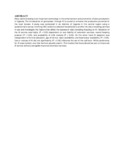| dc.description.abstract | Dairy cattle breeding is an important technology in the enhancement and promotion of dairy production in Uganda. The introduction of germplasm through AI is crucial to enhance the production potential of the local breeds. A study was conducted in six districts of Uganda in the central region using a questionnaire survey involving 450 randomly selected households to profile the dairy breeding services in use and investigate the factors that affect the success of dairy breeding focusing on AI. Adoption of the AI service was highly (P < 0.05) dependent on ava ilability of extension services, record keeping practice (P < 0.05), and availability of milk markets (P < 0.05). On the other hand AI adoption was independent of formal education, age of farmer, labor availability, and feed/water availability (P > 0.05). Use or nonuse of AI did not significantly (P > 0.05) influence the sex of the calf born. While preference for AI was marked, very few farmers actually used it. This implies that focus should be put on improved AI service delivery alongside improved extension services. | en_US |

